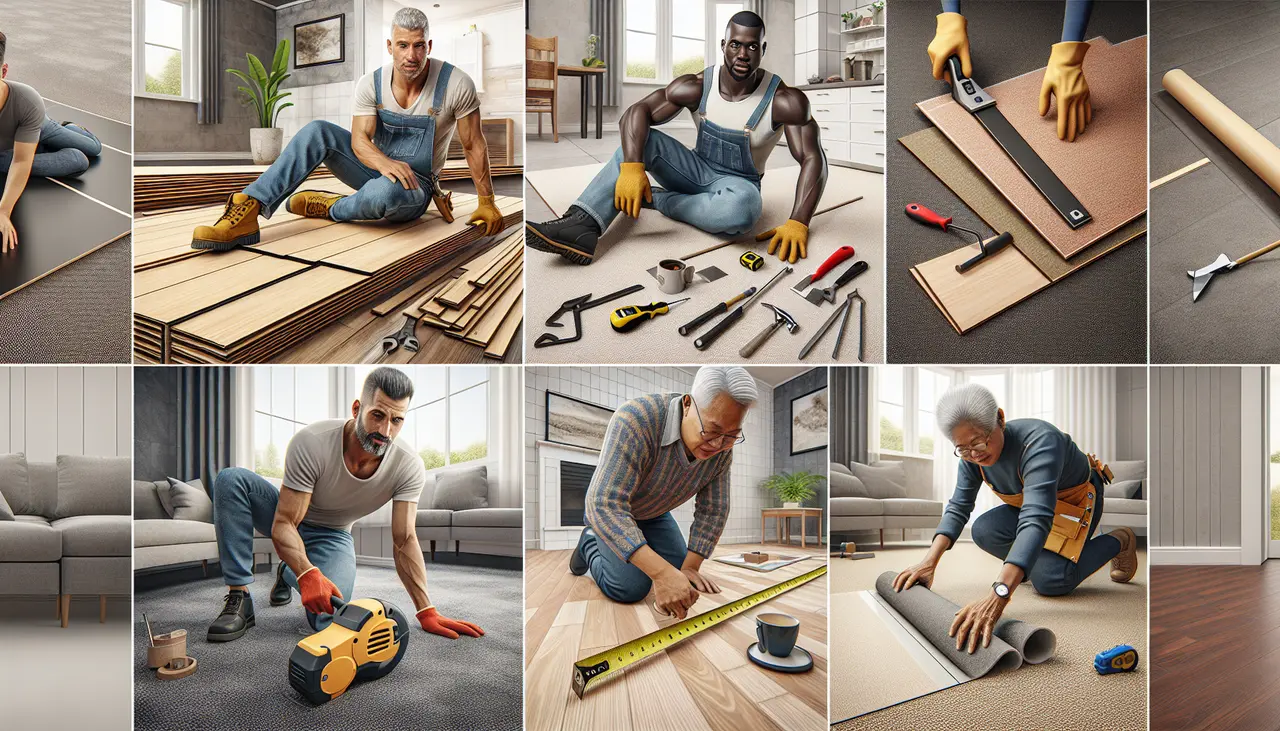Introduction to Budget Flooring Options – ElmWood Flooring, Chicago, IL
Choosing the right flooring can make a big difference in your home without emptying your wallet. ElmWood Flooring is here to help. Let’s dive into budget-friendly flooring options that are both affordable and stylish. First up, laminate flooring stands out for its cost-effectiveness and ease of installation. It mimics the look of hardwood or stone at a fraction of the price. Next, vinyl flooring offers durability and water resistance, making it ideal for kitchens and bathrooms. It also comes in various designs and is easy on the wallet. Ceramic tiles are another option worth considering. They are easy to clean, resistant to scratches, and suitable for wet areas. Although tile installation might be tricky, the material cost can be quite low, especially if you snag a deal. Lastly, carpet tiles might be the way to go if you’re looking for comfort. They can be cheaper than traditional carpet rolls and offer the flexibility to replace stained or damaged squares instead of the whole carpet. Remember, choosing the right flooring is about balancing cost, aesthetics, and practicality.
Preparing Your Space for Budget Flooring Installation
Before you dive into installing new flooring, clearing and prepping your space is crucial. It’s not just about saving money; it’s about making the process smoother and avoiding costly mistakes. First, move all furniture and personal items out of the room. You want a clean slate. Next, tackle the old flooring. If you have carpet, rip it out. For tiles or hardwood, ensure it’s removed properly. Sometimes, you might need to smooth the underlayer, especially if you’re laying down something new like laminate or vinyl. Also, check for moisture or uneven areas—these could ruin your new flooring if not addressed. Lastly, clean the surface thoroughly. Dust or debris will interfere with the installation. By prepping your space effectively, you set the stage for a successful, budget-friendly flooring upgrade.
Tools and Materials Needed for DIY Flooring
For any DIY flooring project, you’ll need the right set of tools and materials. Here’s a basic rundown. First off, a tape measure, pencil, and chalk line are essential for taking accurate measurements and marking. You can’t just eyeball this; precision is key. Absolutely need a good saw. Power saws make cuts fast and straight, but a handsaw works too if you’re on a strict budget or prefer a workout. Don’t forget a trowel or spacers for laying tiles or laminate pieces evenly. An adhesive might be needed, depending on your flooring choice. For tiles, get thin-set mortar or tile adhesive. For hardwood or laminate, an underlayment is crucial for cushioning and noise reduction. Lastly, a hammer or rubber mallet and a pull bar will help snugly fit the pieces together. Remember, the right tools make the job smoother and helps make flooring last longer. So, gather your gear and materials before you start laying down any new floors.
Measuring and Buying Your Budget Flooring
Measuring your space right is the first step to saving cash on flooring. Don’t guess your room’s size; measure it. Here’s how: grab your tape measure, measure the length and the width of your room, and multiply those numbers together. This gives you the square footage. Simple, right? Now, for buying flooring, keep your eyes open for sales and clearance deals. You need to know exactly how much flooring you need, so you don’t overspend or run short. Tip: buy a bit extra, about 10% more, just in case you make a mistake or need to replace a piece later. Remember, buying in bulk can also save you money. So, measure carefully, buy wisely, and always look for the best deal out there.
Step-by-Step Guide to Installing Laminate Flooring on a Budget
First off, grab your tools and materials. You’ll need a laminate flooring installation kit, underlayment, and, of course, your laminate planks. Don’t skimp on quality for price; it’ll save you headaches later. Step one, clear the room. Get everything out of there. Furniture, rugs, the works. You need a blank canvas. Step two, measure up. Know your room’s square footage to buy the right amount of laminate. Buy a bit extra for mistakes or tricky spots. Step three, lay down your underlayment. This stuff is gold for preventing moisture and noise. Just roll it out and tape it down at the seams. Easy. Now, the fun part, laying the planks. Start in one corner and work your way across. Click them together tight. No gaps. If you need to cut a plank to fit, mark and measure twice, cut once. Trust me. Last step, add trims and molding to cover the expansion gaps. It gives it that finished look. And bam, you’ve got a fresh floor for way less cash. Keep it simple, take your time, and your wallet will thank you.
Tips for Laying Vinyl Planks to Save Money
When it comes to laying vinyl planks, doing it yourself can save you a heap of money. First off, make sure the floor is clean and level. Any dirt or bumps can make your planks lay weird. Next, measure your room to know exactly how many planks you’ll need. Buying a little extra is smart in case you mess up a cut. When cutting planks to fit, use a sharp utility knife and a straight edge. This makes sure your cuts are clean and straight. Start laying your planks from the corner of the room and work your way across. Also, stagger the ends of the planks in adjacent rows to make the floor stronger and look better. Don’t rush. Taking your time to line up the planks right will save you from a headache later. Finally, roll over the finished floor with a heavy roller to make sure everything sticks to the ground well. By following these steps, you’re looking at a floor that’s not just budget-friendly but also something you can be proud of.
How to Install Budget-Friendly Carpet Tiles
Carpet tiles are a great way to refresh your space without breaking the bank. Here’s how to lay them down easily. First, clean your floor thoroughly. Any dirt or debris could make the tiles not stick well. Measure your room to know how many tiles you’ll need. Add 10% more to your total for any mistakes or future replacements. Start laying tiles from the center of the room. This way, any cuts you need to make will be on the edges, less visible. Peel off the backing and press the tile down firmly. Make sure the arrows on the back of each tile point in the same direction for a uniform look. If you need to cut a tile, just use a sharp utility knife and a straight edge. Lastly, give the floor a good press or roll with a roller to ensure everything is stuck down well. That’s it. You’ve refreshed your room with a new look at a fraction of the cost.
Finishing Touches: Trims and Moldings on a Dime
Finishing your floors isn’t just about laying down tiles or hardwood. The real magic happens when you add those final details: trims and moldings. But hey, you’ve already spent a good chunk of your budget on the main flooring, so let’s do these finishing touches without breaking the bank. First off, know that trims and moldings are your floor’s best friends. They cover the gaps and make the edges look neat. The trick is to go for materials that look high-end but aren’t pricey. MDF (Medium Density Fiberboard) is a wallet-friendly option that can mimic the look of wood without the hefty price tag. It paints well, too, so you can customize it to match your floor or room’s decor. Shopping at discount or salvage stores is another smart move. Often, you can find high-quality trims and moldings at a fraction of the cost—just be ready to hunt. And here’s a simple hack: if you’re handy with tools, buy larger pieces and cut them down to size yourself. It’s cheaper and gives you control over the final look. Remember, the goal is to achieve a polished appearance without flushing money down the drain. With a bit of creativity and elbow grease, your floors will look like a million bucks, even if you haven’t spent it.
Maintenance and Care for Your New Flooring
Once your new flooring is in place, keeping it looking its best requires some attention. Regular cleaning is key. For most types, a soft broom and a damp mop are enough to keep the surface shiny and clean. Avoid harsh chemicals that can damage the flooring. If you’ve opted for wood, consider using mats at entrances to catch dirt and grit that can scratch the surface. For tiled areas, sealing the grout can prevent stains and moisture damage. Carpets, on the other hand, benefit from frequent vacuuming and the occasional deep clean. Remember, immediate attention to spills prevents stains and long-term damage. A little effort goes a long way in maintaining your new flooring’s appeal and longevity.
Conclusion: Maximizing Value with DIY Budget Flooring Installation
Tackling your own flooring installation is a brilliant way to save cash and achieve a sense of accomplishment. Remember, choosing the right materials and preparing properly will make or break your project. Opt for durable, cost-effective flooring that matches your skills level. Don’t skimp on tools — rent or borrow high-quality ones to ensure a professional finish. Take your time. Rushed jobs often look it. Finally, patience and perseverance pay off. You might hit snags, but with research and persistence, you’ll enjoy your new floors knowing you maximized value on a budget. Stay budget-wise but be smart about where to cut corners.





